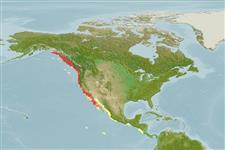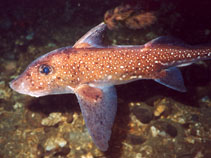Hydrolagus colliei (Lay & Bennett, 1839)
Spotted ratfish
Add your observation in Fish Watcher
| Native range | All suitable habitat | Point map | Year 2050 |

|
| This map was computer-generated and has not yet been reviewed. |
| Hydrolagus colliei AquaMaps Data sources: GBIF OBIS |
Upload your photos and videos
Pictures | Videos | Google imageHydrolagus colliei
Picture by Nichols, J.
Pictures | Videos | Google imageHydrolagus colliei
Picture by Nichols, J.
United States (contiguous states) country information
Common names:
Ratfish, Spotted ratfish, Spotted rattfish
Occurrence: native
Salinity: marine
Abundance: | Ref:
Importance: | Ref:
Aquaculture: | Ref:
Regulations: | Ref:
Uses: no uses
Comments: Occurs in Monterey Bay (Ref. 12091). Common on sandy beaches in Puget Sound, Washington in 1895 (Ref. 28609). Also Ref. 4925, 6793.
National Checklist:
Country Information: https://www.cia.gov/library/publications/resources/the-world-factbook/geos/us.html
National Fisheries Authority: http://www.nmfs.gov
Occurrences: Occurrences Point map
Main Ref: Eschmeyer, W.N., E.S. Herald and H. Hammann, 1983
National Database:
Occurrence: native
Salinity: marine
Abundance: | Ref:
Importance: | Ref:
Aquaculture: | Ref:
Regulations: | Ref:
Uses: no uses
Comments: Occurs in Monterey Bay (Ref. 12091). Common on sandy beaches in Puget Sound, Washington in 1895 (Ref. 28609). Also Ref. 4925, 6793.
National Checklist:
Country Information: https://www.cia.gov/library/publications/resources/the-world-factbook/geos/us.html
National Fisheries Authority: http://www.nmfs.gov
Occurrences: Occurrences Point map
Main Ref: Eschmeyer, W.N., E.S. Herald and H. Hammann, 1983
National Database:
Common names from other countries
Classification / Names Populärnamn | synonymer | Catalog of Fishes(Släkte, Arter) | ITIS | CoL | WoRMS | Cloffa
Holocephali (helhuvudsfiskar) (chimaeras) > Chimaeriformes (Chimaeras) > Chimaeridae (Shortnose chimaeras or ratfishes)
Etymology: Hydrolagus: hydro-, combining form of hydor (Gr.), water; lagos (Gr.), hare, i.e., “water rabbit,” probably referring to three pairs of tooth plates, which tend to protrude from the mouth like a rabbit’s incisors (See ETYFish); colliei: In honor of Alexander Collie (1793‒1835), Scottish surgeon-naturalist aboard HMS Blossom, from which holotype was collected; his notes formed the basis of Lay & Bennett’s description (See ETYFish).
Eponymy: Lieutenant Dr Alexander Collie (1793–1835) was the naval surgeon and naturalist on an expedition (1825–1828) led by Captain Frederick Beechey on ‘HMS Blossom’. [...] (Ref. 128868), visit book page.
More on authors: Lay & Bennett.
Etymology: Hydrolagus: hydro-, combining form of hydor (Gr.), water; lagos (Gr.), hare, i.e., “water rabbit,” probably referring to three pairs of tooth plates, which tend to protrude from the mouth like a rabbit’s incisors (See ETYFish); colliei: In honor of Alexander Collie (1793‒1835), Scottish surgeon-naturalist aboard HMS Blossom, from which holotype was collected; his notes formed the basis of Lay & Bennett’s description (See ETYFish).
Eponymy: Lieutenant Dr Alexander Collie (1793–1835) was the naval surgeon and naturalist on an expedition (1825–1828) led by Captain Frederick Beechey on ‘HMS Blossom’. [...] (Ref. 128868), visit book page.
More on authors: Lay & Bennett.
Environment: milieu / climate zone / depth range / distribution range Ekologi
marina djupbottenlevande; djupintervall 0 - 913 m (Ref. 6793), usually 50 - 400 m (Ref. 43939). Temperate; 59°N - 8°N, 141°W - 83°W
Utbredning Länder | FAO områden | Ekosystem | Förekomster | Point map | Utplanteringar | Faunafri
Northeastern Pacific: west coast of North America from southwestern Alaska to Baja California, Mexico, including the Gulf of California, and Costa Rica.
Length at first maturity / Size / Vikt / Age
Short description Bestämningsnycklar | Morfologi | Morfometri
This species is distinguished by the following characters: short and bluntly rounded snout; oral and preopercular lateral line canals not sharing a short common branch from the infraorbital canal; anterior edge of dorsal-fin spine non-serrated; anterior and posterior regions of second dorsal-fin considerably taller than the middle region; pectoral fins when depressed do not reach beyond to origin of pelvic fins; no anal fin; caudal-fin axis horizontal with the fin nearly symmetrical, epaxial
and hypaxial lobes equal sized; coloration brown or reddish brown with small white spots on head and trunk (Ref. 97389).
Found near the bottom, from close inshore to about 913 m (Ref. 2850). Abundant in cold waters at moderate depths. Feed on mollusks, crustaceans and fishes (Ref. 37955); also echinoderms and worms (Ref. 28499). The spine can be dangerous and cause a painful wound (Ref. 2850). Fishers are reputed to fear the jaws of the ratfish more than they do the dorsal spine. Its flesh is edible but bland and leaves an unpleasant aftertaste (Ref. 28499). The liver was used as a source of machine oil (Ref. 28499).
Life cycle and mating behavior Könsmognad | Reproduktion | Lek | Ägg | Fecundity | Larver
Distinct pairing during copulation (Ref. 205). The female extrudes two eggs at a time (each contained in a capsule) and may take up to 30 hours to extrude all her egg cases, which then hang from her body on a long filament for another 4 to 6 days. The egg cases end up planted vertically in the mud or just lying with filaments entangled on the bottom. Females extruding egss can be found year-round (Ref. 28499).
Main reference
Upload your references | referenser | Koordinator | Medarbetare
Allen, M.J. and G.B. Smith, 1988. Atlas and zoogeography of common fishes in the Bering Sea and northeastern Pacific. NOAA Tech. Rep. NMFS 66, 151 p. (Ref. 6793)
Human uses
Fiskeri: saknar intresse; sportfisk: ja; Akvarium: Offentliga akvarier
FAO(fiskeri: produktion; publication : search) | FishSource | Sea Around Us
Ytterligare information
Population dynamics
Tillväxtparametrar
Max. ages / sizes
Length-weight rel.
Length-length rel.
Length-frequencies
Mass conversion
Rekrytering
Abundans
Tillväxtparametrar
Max. ages / sizes
Length-weight rel.
Length-length rel.
Length-frequencies
Mass conversion
Rekrytering
Abundans
Life cycle
Reproduktion
Könsmognad
Fecundity
Lek
Spawning aggregations
Ägg
Egg development
Larver
Larvdynamik
Reproduktion
Könsmognad
Fecundity
Lek
Spawning aggregations
Ägg
Egg development
Larver
Larvdynamik
Anatomy
Gälyta
Brain
Otolith
Gälyta
Brain
Otolith
Physiology
Body composition
Nutrients
Syreförbrukning
Swimming type
Simhastighet
Visual pigments
Fish sound
Diseases & Parasites
Toxicity (LC50s)
Body composition
Nutrients
Syreförbrukning
Swimming type
Simhastighet
Visual pigments
Fish sound
Diseases & Parasites
Toxicity (LC50s)
Human related
Aquaculture systems
Vattenbruksprofiler
Avelslinjer
Ciguatera cases
Stamps, coins, misc.
Aquaculture systems
Vattenbruksprofiler
Avelslinjer
Ciguatera cases
Stamps, coins, misc.
Verktyg
Bio-Quiz | E-book | Fälthandbok | Bestämningsnycklar | Längdfördelnings-verktyg | Livshistorie-verktyg | Prickkarta | Classification Tree
| Catch-MSY |
Special reports
Download XML
Internet-källor
Aquatic Commons | BHL | Cloffa | Websites from users | Check FishWatcher | CISTI | Catalog of Fishes(Släkte, Arter) | DiscoverLife | ECOTOX | Faunafri | Fishtrace | GenBank(genome, nucleotide) | GloBI | GOBASE | | Google Books | Google Scholar | Google | IGFA World Record | MitoFish | Otolith Atlas of Taiwan Fishes | Offentliga akvarier | PubMed | Reef Life Survey | Scirus | SeaLifeBase | Tree of Life | Wikipedia(Go, sök) | World Records Freshwater Fishing | Zoological Record
Estimates based on models
Preferred temperature (Ref. 115969): 5.1 - 9.7, mean 7.5 (based on 115 cells).
Phylogenetic diversity index (Ref. 82804): PD50 = 0.5000 [Uniqueness, from 0.5 = low to 2.0 = high].
Bayesian length-weight: a=0.00331 (0.00137 - 0.00798), b=3.07 (2.86 - 3.28), in cm Total Length, based on LWR estimates for this (Sub)family-body shape (Ref. 93245).
Trofisk nivå (Ref. 69278): 3.7 ±0.54 se; based on food items.
Resiliens (Ref. 120179): Låg, lägsta populationsfördubblingstid 4,5-14 år (K=0.2-0.22; Fec=2).
Fishing Vulnerability (Ref. 59153): Moderate to high vulnerability (50 of 100).
Climate Vulnerability (Ref. 125649): Moderate to high vulnerability (47 of 100).




